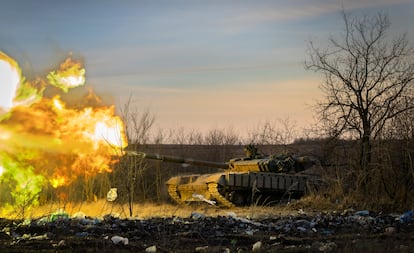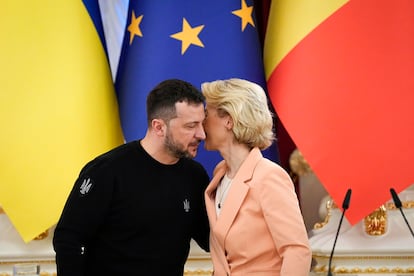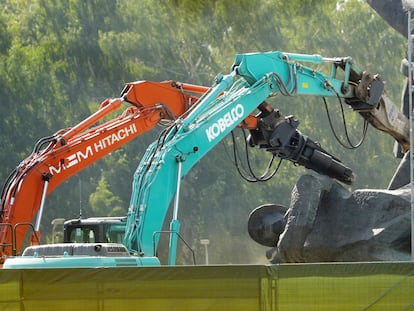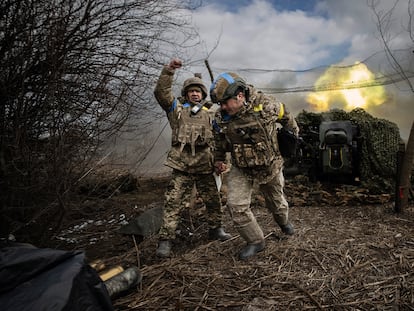Europe gets ready for war
The EU is going through a metamorphosis that seeks to dissuade Putin from undertaking new aggression and guarantee its autonomy in a turbulent world

More ammunition, more weapons production, more investment and coordination in defense capabilities. Europe is on the warpath. EU member states are increasing their spending in defense and the European Union — a project aimed at maintaining peace without a military component — is now metamorphosing into a model with a strong focus on defense, as it aims to protect itself from external threats in turbulent times.
The path of this metamorphosis is marked by Russia’s war against Ukraine, which has entered its third year. Kyiv’s troops are struggling due to the lack of ammunition and the paralysis of U.S. aid, the Kremlin is proving more resilient than expected, China is increasingly assertive, and there are growing concerns over what will happen to U.S. support if Donald Trump returns to the White House or if Washington focuses its efforts on another of its areas of interest: the Asian giant. The Old Continent has recognized its fragile position and lack of means if another conflict were to arise.
“The threat of war may not be imminent, but it is not impossible,” the president of the European Commission, Ursula von der Leyen, told the plenary session of the European Parliament last week, stressing that “it is time for Europe to step up.” The warning from the conservative leader, who was Germany’s minister of defense for more than five years, shocked many due to its severity, a diplomatic source told EL PAÍS. But it is one more move towards a paradigm shift in the EU, where some member states are already talking about bringing back reservists (Belgium), while others asking their citizens to mentally prepare for war (Sweden).
In other words, Von der Leyen’s address is just the latest in a slew of statements warning of the risk that Russian President Vladimir Putin will attack a European country and NATO ally to try to test the NATO’s mutual defense pledge, which states that an attack on any member of the Alliance is an attack against all. “Our experts expect that in a period of five to eight years this could be possible,” German Defense Minister Boris Pistorius warned a few weeks ago. Meanwhile, the Danish Defense Minister, Troels Lund Poulsen, argued that the hypothetical attack could happen even earlier: “This was not NATO’s assessment in 2023. This is new knowledge that is coming to the fore now,” he stated.
Amid this background, Europe is rearming itself. In 2014, when Russia annexed Crimea, European NATO allies spent $235 billion or 1.47% of GDP on defense. In 2023, that figure rose to $347 billion (both calculated in 2015 prices), equivalent to 1.85% of GDP. By 2024, defense expenditure is expected to reach $380 billion and 2% of GDP, according to NATO data. Everything indicates that these figures will continue to rise sharply. Today, 10 of the 22 European members of NATO have exceeded the objective of spending 2% of GDP on defense and 17 more are expected to do so by the end of 2024. But NATO wants this to be the floor, not the ceiling of expenditure.

The European Union, for its part, took a historic step when Putin launched the large-scale invasion of Ukraine in 2022 and it decided to support Kyiv militarily with intergovernmental funds. The EU has committed €35.5 billion to Ukraine for military supplies. If financial support is also taken into account, the EU has provided more aid to Kyiv than the United States, recalls a Western diplomat. However, the EU has not fulfilled its promise to deliver one million artillery rounds and this is evident on the battle front, where, after Ukraine’s failed counteroffensive, troops are rationing ammunition.
Russia, with its economy focused on defense production, has help from Iran and North Korea. Meanwhile, the European industry has increased its production capacity by 40%, according to EU data. But companies say they want long-term orders. And EU members have still not reached that point.
There is a “storm of worry,” says Carmen Claudín, senior associate researcher at the CIDOB analysis center. She points to not only the stalled progress on the battle front due to the West’s insufficient support for Ukraine and the fear that Trump will return to the White House; but also to the upcoming European elections in June, where polls predict far-right and populist forces, many of them pro-Russian, are set to make gains. “The murder of the opponent Alexei Navalny has once again reminded us who we have in front of us,” she adds.
Strategy to deter Putin
The European Commission is now working on another axis, which highlights the profound metamorphosis of the EU: a new defense industrial strategy to promote weapons production, which is currently uneven and fragmented. It is also trying to scrape together funds to fill its arsenals and launch new projects, while dealing with tight budgets. The plan is based on a joint purchasing system — the same one used to purchase Covid-19 vaccines. The goal is to increase the use of this payment system to increase orders and secure the supply chain. Under this plan, half of the purchases (in market value) will be made to European companies. It also proposes creating strategic warehouses of basic components, in case a crisis occurs, according to the draft of the document seen by EL PAÍS.
The strategy marks a historic paradigm shift in the EU. It even suggests that the European Investment Bank (EIB) change its credit policy to finance companies that manufacture weapons and ammunition; and not just dual-use goods, such as drones and radars.
The turbulent times have sparked a sense of urgency. Europe wants to become much more capable of defense in order to support Ukraine in the short term and, above all, to deter Russia in the medium term. Europe is not facing a “one-off crisis,” points out William Alberque, director of Strategy, Techonology and Arms Control at the International Institute for Strategic Studies (IISS). “The problem is Russia. And if we do not have the determination to deter it, then it will attack again,” he says.
Putin — who is celebrating a quarter of a century in power this year and next month faces elections, with no rivals, to remain at the helm of the Kremlin until 2030 — is a distant threat for some countries such as Italy or Spain, which feel more affected by instability in the Middle East, according to the surveys. But Russia is very close to others like the Baltic countries or Poland, which have their own history and experience with Russian imperialism. Despite the territorial differences, all signs point to a change in the mentality of generations of European citizens, who have never experienced a war up close or ever felt the threat as imminent.
Inside NATO, the official alert level has not changed. So is really possible that Putin will attack outside Ukrainian territory? “Although we cannot rule out the possibility of isolated aggressions, Russia does not seem to be in a position to sustain a military offensive in a NATO country in the short term, since the situation in Ukraine has tied up Russian forces,” says Luis Simón, director of the Elcano Royal Institute Office in Brussels. In the medium term, says the expert, it will depend on how the situation in Ukraine and the political direction of the United States evolve. “Even in the face of unfavorable developments in these areas, it does not seem that Russia is in a position to sustain a large-scale military offensive against a NATO country, since it will take time to rebuild its force structure,” adds Simón.
Added to this is the accession of Finland and Sweden into NATO. With the two Nordic countries, the Alliance now has 32 members and it has reinforced the defense position of the Baltic countries. The war in Ukraine also shows that resistance is possible, which underlines deterrence.
“If Europeans take the issue of defense seriously, Russia will not attack. Russia attacks where it smells weakness, not where it perceives strength,” says Alberque, who was director of NATO’s Center for Arms Control, Disarmament and Non-Proliferation. “That is the challenge for Europeans. Are we willing to make a long-term effort?” he asks. “Unfortunately, Europe has neglected its defense for 30 years. To prepare public opinion, leaders must take a step forward, take some risks, tell uncomfortable truths. Unfortunately, if Trump wins, the risk is credible,” he adds.
Nuclear arsenals
These growing and increasingly serious warnings seek to help the public understand the changes being sought, says a NATO source. The risk of a Russian attack remains very low. But if the war in Ukraine ends in a positive result, Russia is likely to rebuild its forces with its war economy. And if Trump wins the November presidential election, and there is turbulence in East Asia that distracts Washington, then nothing can be ruled out.
The possible victory of Trump, who has questioned NATO’s mutual defense pledge, may lead to a complicated debate about Europe’s nuclear protection. France, the only EU member country with nuclear weapons, recently moved to open a debate on the issue with its partners. The United Kingdom also has nuclear weapons. Although their joint arsenals are smaller than Russia’s, they have hundreds of nuclear warheads that undoubtedly have deterrence capabilities.
Under what circumstances, under what terms, might London and Paris consider acting in defense of a European partner? This is a very thorny issue that may have to be addressed urgently after the U.S. elections in November.
What’s more, the threat is not just of a traditional attack. Putin — the great destabilizer who has made moves to unbalance Moldova — will use the Kaliningrad enclave and the North Sea to intimidate his neighbors, says an intelligence officer from a European country. According to this source, this is likely to coincide with the European and U.S. presidential elections. Disinformation, interference and attacks on essential infrastructure are also part of the threat posed by Russia.
“We find ourselves at the dawn of a new, more turbulent and difficult era,” Danish Prime Minister Mette Frederiksen said on Saturday in Rome. “Regardless of what happens in the United States, we must increase our support for Ukraine, invest more in defense, in military support. And we have to assume our responsibility and continue to join forces, with internal cooperation in the EU and expand it.”
Strengthening European defense will require the continent to face and resolve multiple issues. One such issue is defining the balance between the interest in strengthening the European industrial base, with orders from local manufacturers, and the interest in urgently strengthening combat capabilities, which often means weapons manufactured in other markets are given preference. The Spanish Armed Forces, for example, which need to replace their Harrier fighter planes, which will exhaust their service period at the end of this decade, and according to experts, America’s F -35 are the most logical replacement.
Frictions in Europe
Another important issue will be increasing the interoperability of the weapons of the different European forces more. Fragmentation in Europe is very high. In the joint German-Dutch unit, for example, both parties use 155 caliber ammunition, but it is not interchangeable due to slight manufacturing differences.
The initiative to boost European defense will involve power struggles on several axes: between the EU Commission and EU Council, between Brussels and member states and between the EU and NATO, entities that are now strengthening their cooperation.
This friction is already present. For months, the EU has been trying to approve a special program to finance weapons for Ukraine, with €5 billion in the first tranche. And this time it is not just Hungary that is blocking the move. France and Germany are clashing over the core short-term strategy, with Paris demanding European purchases, and Berlin — along with other allies — calling for urgent purchases. It also wants this fund to prioritize reimbursements for bilateral deliveries and not joint acquisitions.
Meanwhile, the warnings continue. “Russia has adopted a more aggressive attitude, not only in Ukraine, but in general,” French President Emmanuel Macron said last week. We firmly believe that Russia’s defeat is pivotal for Europe’s security and stability,” he added, arguing that sending troops to Ukraine should not be ruled out. The possibility of an allied country officially putting boots on the ground in the invaded country, even as instructors — as contemplated by the EU’s security commitment project with Kyiv — or for de-mining and military advisory tasks, is perceived as distant.
In fact, the French leader’s statement, which is framed within the so-called “strategic ambiguity”— that is, not giving clues to the enemy — unleashed a cascade of statements from Germany, the United Kingdom, Sweden, Poland and Spain, which have ruled out the possibility of sending troops. But this also happened with the war material. Berlin offered helmets and sleeping bags in the first stages of the invasion and is now sending artillery and tanks.
Sign up for our weekly newsletter to get more English-language news coverage from EL PAÍS USA Edition
Tu suscripción se está usando en otro dispositivo
¿Quieres añadir otro usuario a tu suscripción?
Si continúas leyendo en este dispositivo, no se podrá leer en el otro.
FlechaTu suscripción se está usando en otro dispositivo y solo puedes acceder a EL PAÍS desde un dispositivo a la vez.
Si quieres compartir tu cuenta, cambia tu suscripción a la modalidad Premium, así podrás añadir otro usuario. Cada uno accederá con su propia cuenta de email, lo que os permitirá personalizar vuestra experiencia en EL PAÍS.
¿Tienes una suscripción de empresa? Accede aquí para contratar más cuentas.
En el caso de no saber quién está usando tu cuenta, te recomendamos cambiar tu contraseña aquí.
Si decides continuar compartiendo tu cuenta, este mensaje se mostrará en tu dispositivo y en el de la otra persona que está usando tu cuenta de forma indefinida, afectando a tu experiencia de lectura. Puedes consultar aquí los términos y condiciones de la suscripción digital.










































